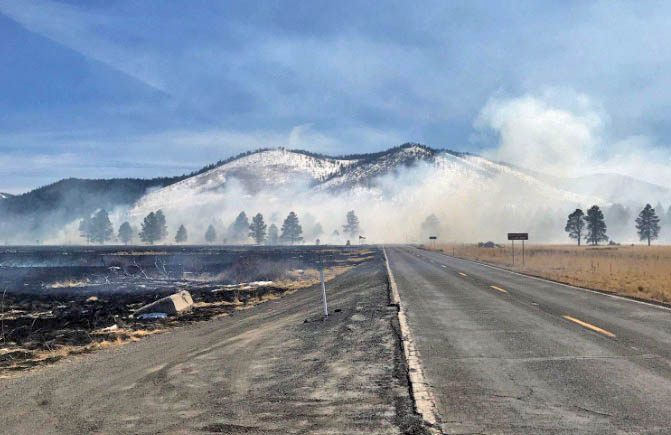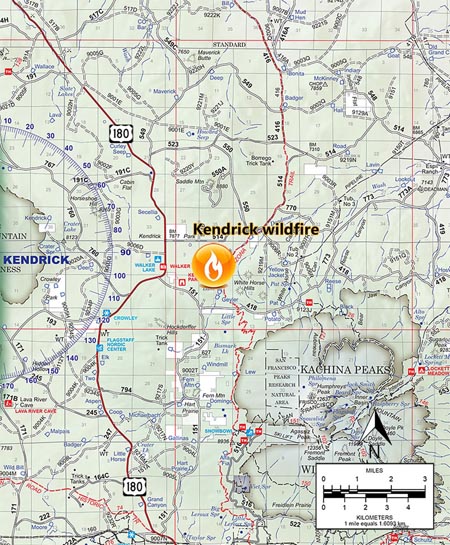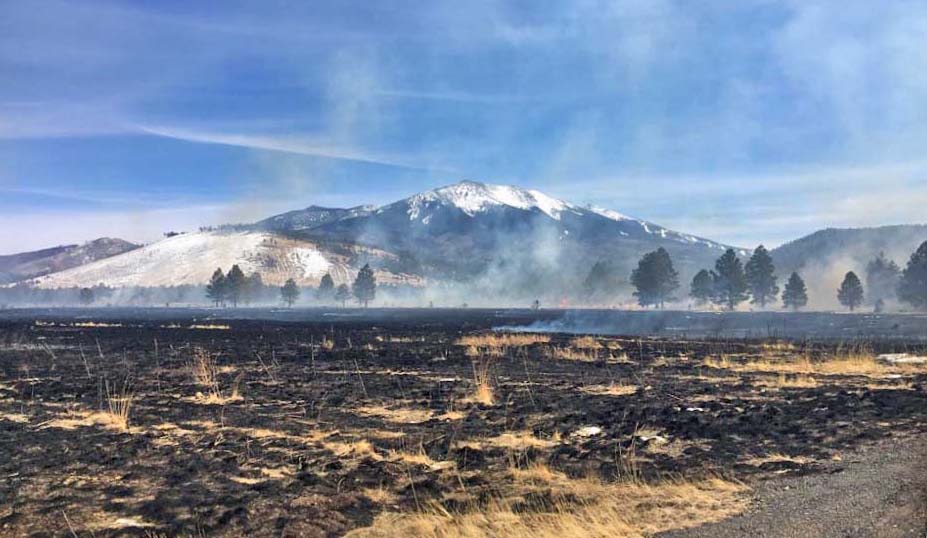(UPDATED at 11:33 a.m. MST March 7, 2018)
The drone that landed, caught fire, and ignited what became a 335-acre fire in Northern Arizona was battery-powered and approximately 16″ x 16″, a spokesperson for the Coconino National Forest said. The operator reported the fire and was later cited for causing timber, trees, slash, brush, or grass to burn. The spokesperson did not know exactly how the drone caught fire.
****
(Originally published at 4:42 p.m. MST March 6, 2018)

This article first appeared on Fire Aviation.
There’s no doubt that Unmanned Aerial Systems can play an important part in improving situational awareness for wildland firefighters.
But today investigators have determined that the preliminary cause of a wildfire north of Flagstaff is a drone that landed and caught fire. At 3:25 p.m. MST Tuesday the Coconino National Forest said firefighters had stopped the spread of the resulting wildfire after it burned 335 acres near Kendrick Park by Forest Roads 514 and 524.
There is no information yet about the operator of the drone or if it was powered by a battery or gasoline.
All of these photos were provided by the Coconino National Forest.

Thanks and a tip of the hat go out to Tom.
Typos or errors, report them HERE.



good grief, that track record is almost as bad as sky lanterns.
I have a DJI Mavic Pro drone. The owners manual has some interesting information in the “Intelligent Flight Battery Functions” section. Here are some excerpts:
2. Auto-Discharging Function: To prevent swelling, the battery automatically discharges to below 65% of total power when it is idle for more than 10 days. It takes around two days to discharge the battery to 65%. It is normal to feel moderate heat being emitted from the battery during the discharge process. Discharge thresholds can be set in the DJI GO app.
8. Short Circuit Protection: Automatically cuts the power supply when a short circuit is detected.
Short circuit protection works for external shorts … if the problem is internal to the battery it will probably burn. Lots of the FAA reports above were from fires/smoke/ explosions caused when the battery was damaged.
Bill,
Here’s a summary of FAA reports on Lithium battery problems:
https://www.faa.gov/about/office_org/headquarters_offices/ash/ash_programs/hazmat/aircarrier_info/media/Battery_incident_chart.pdf
46 FAA reported incidents in 2017. Usually damage related but some have thermal runaways with no obvious cause.
Here’s a list from 2010 of 259 RC community lithium battery fire reports:
https://www.rcgroups.com/forums/showpost.php?p=15776103&postcount=4
This isn’t the first time a UAS has caused a wildfire:
http://www.farmweekly.com.au/news/agriculture/agribusiness/general-news/flaming-drone-blamed-for-stubble-fire/2754509.aspx
Somebody correct me if I’m wrong, but the batteries in that second link (the list compiled in 2010 from the RC community) are all “lipo”, or lithium polymer. The batteries in most small consumer drones are lithium ion.
Is this one of the first reported incidents of a drone directly attributed to an ignition? There are numerous reports of injuries and even fatalities (Arizona 2015) but I cannot recall one with a wildfire ignition? Thanks for the reporting you, your team and site do Bill!!
I responded to a small grass fire a few years ago in Colorado which was started by a small drone crashing and catching fire. In our investigation we found the operator lost communication with the quadcopter style drone and it crashed. The lithium ion battery in the drone is less stable than other batteries and can catch fire in the event of a crash.
I wonder if anyone else can confirm that a lithium ion battery is susceptible to catching on fire if involved in a crash.
Be weird if they did and yet still approved for use in drones?
I can confirm a wildfire ignition from a battery operated drone also. This one was a 6 motor model with large batteries similar to an 18v drill battery but Lithium Ion.
BP, can you elaborate on the circumstances? What was the drone doing at the time? Idle on the ground, flying, crashing?
It was flying on our installation and the operator lost signal with it, it fell from about 200ft.
As the flight crew was walking out to pick it up it caught fire in very tall grass. It was a total loss. Talking to the engineers the only thing they thought would have caused enough heat the start the fire were the battery packs.
If it was a dji type video drone then yes they are lithium ion. I build race drones and they use lithium polymer. Much more volitale and make a much larger flame. However noone seems to know if it was elecric or gas. Also they identified the pilot and still no drone type. This is all fishy bill. Very very fishy. If it was a lithium ion type drone it most likely has gps. If it lost signal the gps would go into failsafe and return to home. If it were a race type lithium polymer powered drone it would not have gps, so it falls. But it certainly wouldnt be completely destroyed. You would find the catbon fiber frame and motors and flight controller and ESC, they would find most of the drone in one piece actually. Nothing adds up here.
The lack of information available does not mean the circumstances are “fishy”.
Information in Bean’s link to the FAA report (below) includes several examples of physical damage to a lithium polymer battery that caused overheating and smoke.
Not lithium ion. Lithium polymer. Ion is what your phone runs on.
What? Thought those things ran on a rechargable battery?
They do. Drones are very rarely gas powered. Planes and rc cars are. I dont think it was a drone. I build them amd this all sounds uncharacteristic. Plus they identified the pilot so im sure he would know the aircraft but yet no one seems to know. Fishy…